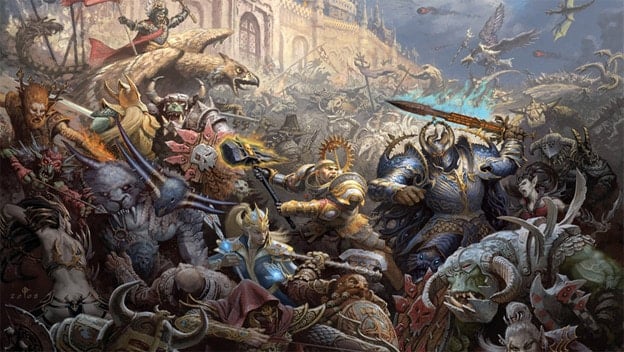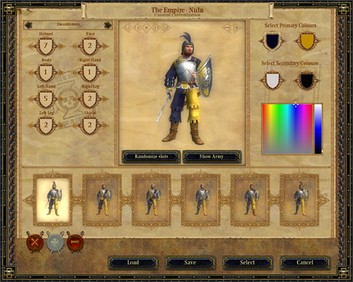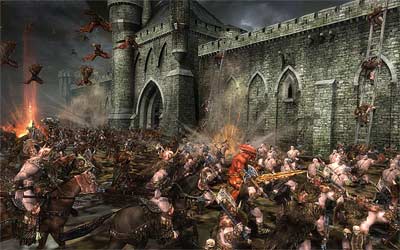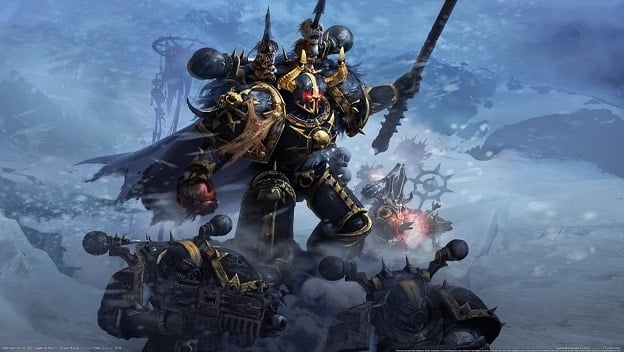Real-time strategy games demand a certain mindset, not shared by all gamers. In Black Hole Entertainment’s 2006 PC hit Warhammer: Mark of Chaos, players weren’t tasked with simply directing armies around, Risk-style; they were in charge of an ever-increasing number of specialized units. They were also put in command of individual “heroes” and “champions,” each with their own special skills. Developer Black Hole Entertainment eliminated the resource management that’s so common in similar titles, but the battle mechanics were still enough of a handful with an entire keyboard’s worth of hotkeys at your disposal. Taking that keyboard and mouse setup and cramming it into an Xbox 360 controller has yielded 2008’s Warhammer: Battle March, an adaptation (the makers object to the term “port”) that includes the Battle March add-on released on PC earlier in the year.
A New Challenge to Conquer

The assault waged here can become absurdly complicated. While it’s easy enough to move a unit around or tell it to attack–select the unit, then the desired location or enemy with the joysticks and A button–a player typically has to hold down a trigger, press a direction on the D-pad, and then choose from four tiny pictures for the A, B, X, and Y buttons. This can be a tough proposition when in the middle of a heated battle.
Big but Fun Learning Curve

The three-part in-game tutorial tries to help, but the game can still make your head spin. Neither the instruction manual nor the in-game “controls” page includes a moves list, and there’s no way to convert the aforementioned tiny pictures to words in the menus. Once you’ve accidentally told a hero to take on a whole group of enemies alone, forgetting the button combination required to stop them can yield disastrous results.
This game’s quirks become apparent early on. For example, say you want one of your units to attack an enemy unit and another of your units to attack a different one. You select the first unit, select the first enemy, select the second unit, and select the other enemy. Unfortunately, selecting the second friendly unit didn’t de-select the first one, so now both of your units are attacking the second enemy unit. You forgot to press B in between. Eventually, after a mission or two in the game’s Skirmish mode, against other humans online, or in one of the three-story modes (Empire, Orc, and Chaos, with more than 60 missions between them), the most basic elements become second nature, and the game gets quite enjoyable. Still, a more complete set of instructions or an easier-to-follow tutorial would have helped to alleviate these early-game woes.
It’s fun to arrange the different units to maximize their effectiveness, even if you’re not quite sure what to do with the heroes (or how to have them join a regular unit). If you so desire, you can ignore the game’s deeper elements, and you can always flip the difficulty setting to “easy” if you’re having a rough go of it. It’s nice to be able to stock up on war items at a town and then head into the next battle without worrying about resource management or figuring out where to go.
Watch Your Army Follow Your Commands

Once you’ve had your forces attack, it can be amusing to zoom in with the camera and watch the action. The fights don’t feel nearly as visceral as they should, though; the soldiers tend to stand still and swing their swords lackadaisically, and it often doesn’t even look as though their hits are connecting. Once in a while there’s a splash of blood, but other than that there’s a distinct lack of visual or aural feedback in combat.
In general, the visuals during battles are nothing special, which is unfortunate because battles make up the majority of the game. The water looks good, a testament to the visual capabilities of the Xbox 360, but the rest of the landscapes, textures, and character models can come off as rather nondescript. The game lacks a unique, artistic visual style or breathtaking sense of realism.
A Story That Keeps You Engaged
By contrast, the cutscenes that introduce the three stories are simply amazing, sometimes to the point where they don’t even look animated. The tale here, insofar as it matters to the game, is this: there was a huge war, and factions are still fighting. Warhammer fans will know exactly what’s going on, and for newcomers these cutscenes to a good enough job of introducing the factions while allowing you to quickly get to the gameplay.
In the course of story mode, other cutscenes further the plot. While colorful, they have a blurrier look, with characters whose mouths are sometimes completely out of sync with the voice acting.
A Decent Adaptation
Overall, this game is a good time and contains enough strategy elements to please fans of the genre. If you already own it on PC, or have a computer that’s capable of running it, then you already have the superior version when it comes to gameplay and visuals. If the Xbox 360 is your main gaming rig, however, this game will easily scratch your real-time strategy itch.
